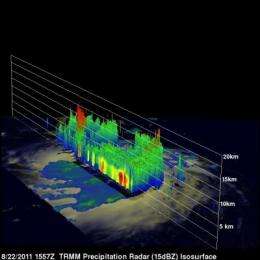This 3-D perspective of Irene was created from TRMM satellite data taken at 15:57 UTC (11:57 a.m. EDT) on August 22, 2011. It revealed an area of deep convection (shown in red) near the storm's center where precipitation-sized particles are being carried aloft. Credit: NASA/SSAI, Hal Pierce
The Tropical Rainfall Measuring Mission satellite has been busy measuring rainfall within Hurricane Irene, and forecasts call for between 5 and 10 inches in the southeastern and central Bahamas and Turks and Caicos Islands as Irene moves toward them today.
It's been a busy season so far in terms of tropical storms with seven named storms already in the Atlantic basin; however, none of them have had a very large impact as they have either been small, short-lived or remained at sea and none of them have intensified into a hurricane until now.
Irene, which originated from a tropical wave that propagated off the west coast of Africa, became the 8th named storm of the season as it approached the Lesser Antilles on the 20th of August and the first hurricane of the season as it was passing over Puerto Rico on the morning of the 22nd. Now back over open water, Irene is poised to pass close to the northern coast of Hispaniola and poses a threat to the Bahamas.
The Tropical Rainfall Measuring Mission (or TRMM) satellite passed directly over Irene as it was leaving Puerto Rico and captured these unique images of the storm as it moving westward near the Dominican Republic. The images were taken at 15:57 UTC (11:57 AM EDT) on 22 August 2011. One image from TRMM data shows a top-down view of the rain intensity within the storm.
An animation of satellite observations from Aug. 21 (11:15 a.m. EDT) to Aug. 23 shows the progression of Hurricane Irene. Irene moved over Puerto Rico on Aug. 22 and is headed to the Bahamas. Irene has grown in size and is a Category 2 hurricane on the Saffir-Simpson scale. Observations from NOAA's GOES-13 satellite. Credit: Super(s): Courtesy: NASA/NOAA GOES Project
Creating the rain rate image is complicated and involves data from three instruments on TRMM. Rain rates in the center of the swath are from the TRMM Precipitation Radar (PR), and those in the outer swath are from the TRMM Microwave Imager (TMI). The rainrates are overlaid on infrared (IR) data from the TRMM Visible Infrared Scanner (VIRS).
TRMM reveals that although a hurricane, Irene has not yet developed an eye and is not yet fully organized. The center of the storm was located just to the southwest of an area of heavy rain (as much as 2 inches/50 mm per hour) about midway between Puerto Rico and the Dominican Republic. Rainbands, containing light to moderate rain curved around the storm mainly to the north and east of the center, revealing the presence of the storm's low pressure circulation, but one that is not yet intense.
The TRMM team at NASA's Goddard Space Flight Center in Greenbelt, Md. also created a 3-D perspective of the storm. It revealed an area of deep convection near the storm's center where precipitation-sized particles are being carried aloft. These tall towers are associated with strong thunderstorms responsible for the area of intense rain near the center of Irene seen in the previous image. They can be a precursor to strengthening as they indicate areas within a storm where vast amounts of heat are being released. This heating, known as latent heating, is what is drives a storm's circulation and intensification.
At the time these images were taken, Irene was a Category 1 hurricane with maximum sustained winds reported at 70 knots (~80 mph) by the National Hurricane Center.
At 8 a.m. EDT on August 23, Irene strengthened into a Category 2 hurricane. Irene's center was headed toward the Turks and Caicos Islands and the southeastern Bahamas. Irene's maximum sustained winds were near 100 mph (160 kmh). It was located near 20.6 North and 70.6 West, about 70 miles south-southeast of Grand Turk Island and moving to the west-northwest near 10 mph (17 kmh). Minimum central pressure is 978 millibars. Various hurricane and tropical storm warnings and watches are in effect and can be found at The National Hurricane Center's website: www.nhc.noaa.gov.
The rainfall rates seen by the TRMM satellite are reflected in the rainfall forecast totals by the National Hurricane Center (NHC) today. The NHC expects another 1 to 3 inches across Puerto Rico, 3 to 6 inches over northern Hispaniola and isolated amounts as high as 10 inches in higher terrain. The southeastern and central Bahamas and Turks and Caicos Islands can expect 5 to 10 inches of rainfall as Irene moves toward them today.
Irene is expected to be over the Turks and Caicos Islands and the southeastern Bahamas tonight and near the central Bahamas early tomorrow. Irene is expected to intensify and is expected to become a major hurricane and residents along the U.S. east coast are keeping close watch.
Provided by NASA's Goddard Space Flight Center
























